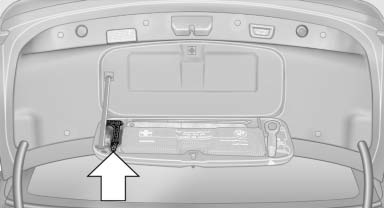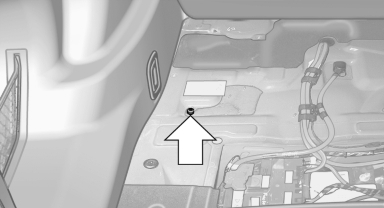Manual release
The parking brake can be released manually in the event of a power failure or electrical fault.
![]() Before releasing, secure the vehicle
against rolling
Before releasing, secure the vehicle
against rolling
Before releasing the parking brake manually, and whenever you park the vehicle with the parking brake released, ensure that position P of the automatic transmission is engaged.
Secure the vehicle in a manner appropriate to the inclination of the road, e.g., with a wheel chock; otherwise, there is the danger of the vehicle rolling.
Unlocking
1. Remove the release tool from the tool kit.

2. Raise the floor panel in the cargo area.

3. Take out the floor trim in the cargo area, removing the screws with the release tool, arrows.

4. Place the release tool on the release point, arrow.

5. Forcefully pull the release tool up against the resistance until you notice a marked increase in the resistance and the parking brake releases audibly.

![]() Have the malfunction corrected
Have the malfunction corrected
If the parking brake has been released manually in response to a malfunction, only technicians can return it to operation.
Have the malfunction corrected by your service center.
See also:
Following part replacement
The same breaking in procedures should be observed
if any of the components mentioned
above have to be renewed in the course of the
vehicle's operating life. ...
Locking
▷ Press the button. The doors are
locked.
▷ Press the lock button of a door. To prevent
you from being locked out, the opened driver's
door cannot be locked using the lock
button. ...
Avoiding unintentional alarms
The tilt alarm sensor and interior motion sensor
can be switched off together, such as in the following
situations:
▷ In automatic car washes.
▷ In duplex garages.
▷ During tr ...
